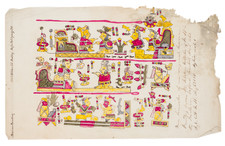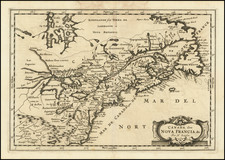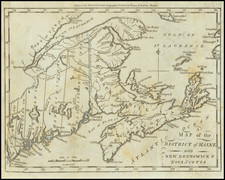A Mexican Warrior -- And Celebration of Red Dye Creation
Scarce image of an indigenous Mexican with bow and arrow, in an indigenous costume.
The image appeared in Happel's Thesaurus Exoticorum, pubished in Hamburg in 1688. The text below reads:
One of the noblest lands in West Indies, indeed in the world, is the land of Mexico which is located between the 15th and 23rd degrees of northern latitude. Here, the grain is harvested twice a year. However, if it remains in the field until the end of the slaughter month, it will freeze, especially in the cold mountains, quite easily.
The fifth kind of Tunas trees, which one usually calls Cumbebazu, grows very abundantly here. Beneath its large leaves, a worm emerges, a little smaller than a flea, which at times also takes on the shape and size of a bedbug. This little worm covers the entire tree with seeds resembling mites. Indeed, it fills a garden of 100 plants with these in just a year. The worm itself is white and lies hidden in a gel-like substance. It is carefully cultivated, killed in cold water or covered in ashes, and then dried. It turns into what is called cochineal. The best and most are found in Alaskala. The mountainous Chichimecas and others, which grow without care, do not dye as well as the true cochineal. The Tunas tree also bears a fruit similar to the monk's cherries, which is covered with a smooth skin from the outside and filled with little seeds, like figs, on the inside. The red ones don't taste as sweet as the white ones and make the urine blood-colored.
The apples of sickness here differ from the Spanish ones in that their flesh is hidden in small shells and that they have a pleasant smell, an appetizing flesh or pulp, and a sharp sweet taste. When salted, they can be preserved for a long time.
The Mexican Chocolate. Even more eyes feast on the fruit Cacao, with which New Spain conducts a very large trade, and they themselves use it as a form of minor currency. . . .
The section describing worms, etc. relates to Tunas Trees & Cochineal, which are a specific type of tree in Mexico, the Tunas tree, hosts a worm that produces seeds similar to mites. This worm is then processed into cochineal, a valuable red dye. The best cochineal is found in Alaskala, and other wild versions don't produce dye as effectively.
Eberhard Werner Happel (1647–1690) was a German author of scientific and historical works. The son of a reformist Lutheran minister, he studied law, mathematics, and natural sciences in Marburg, Germany, from the 1660s to 1680s, though due to financial issues he never finished his formal education. He also tutored aristocratic families in Hessen and Hamburg during this time. Around 1680 he devoted himself to writing, publishing several works of historical fiction. He also published several historical and scientific almanacs, the most famous of which was Historia Moderna Europae, which covered recent European political history and included detailed maps and engravings. His most famous scientific work was Gröste Denkwürdigkeiten der Welt: Oder, So genannte “relationes curiosae”, which contained one of the most important early discussions of oceanographic phenomena. In later years Happel continued to be a successful and widely read author. He died in Hamburg at age 42, survived by his wife, Margarita, and four children.









![(Mexican-Aztec Painting) [Watercolor of three Aztec deities from the Codex Vaticanus:] Toxcatl, God of Droughts and Inundations. Cod. Vat. Tlaloc. God of Water. Cod. Vat. Tecuilvitontl [Tecuilhuitontli] The Lesser Festival of the Lords. Cod. Vat.](https://storage.googleapis.com/raremaps/img/small/103009.jpg)

![(North Dakota) Scalp Dance of the Minatarres [near Fort Clark, on the Missouri River]](https://storage.googleapis.com/raremaps/img/small/77692.jpg)

![[ Virginia Natives -- The Conjurer ] Praestigiator](https://storage.googleapis.com/raremaps/img/small/98754.jpg)
